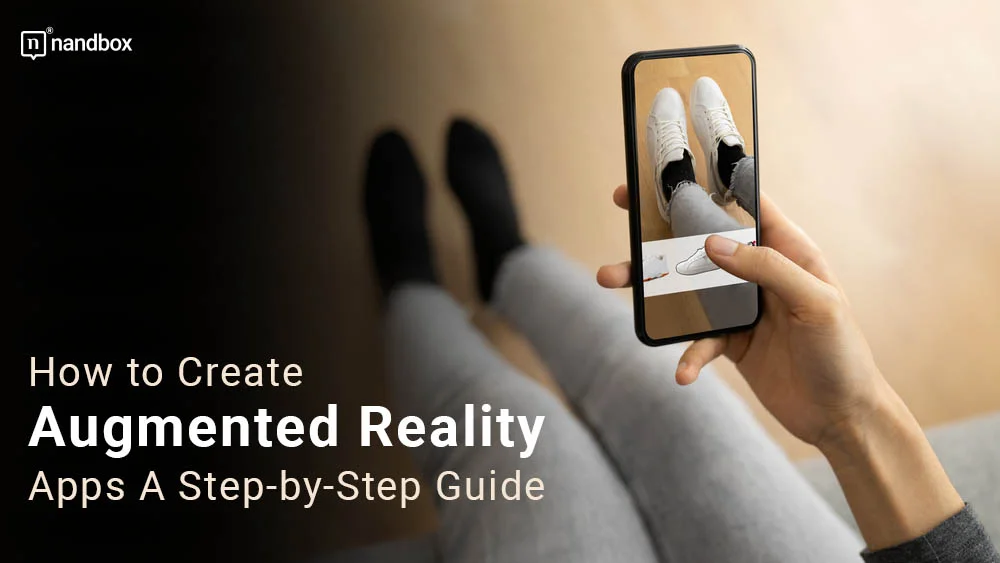You may want to sit back and relax for this one, as it contains many things that can blow your mind. The emergence of many powerful and new technologies might have brought us a step closer to the future we always saw in movies and TV shows. Who would have imagined that we can now communicate with machines and engage in full conversations? Definitely, no one. Also, we would have never imagined that we could shop for clothes and try them on without even stepping out of the house. Wait, we can do that? Absolutely! In this article, we will talk about the astonishing augmented reality that made this possible. We will also guide you through how to create augmented reality apps.
What Is Augmented Reality (AR)
So, what is this breathtaking technology that can make us shop for clothes and go places without moving? This would be augmented reality. Augmented reality is not a recent technology; it has been around for quite some time. However, we can say that it was in progress until it reached a very prominent and mind-blowing phase. The idea of augmented reality dates back to 1968, when scientists were working on the first-ever AR display, with the first AR app being “AR Tennis” in 2000, which was available on all Nokia phones.
Briefly, augmented reality is a technology that allows mobile app users to display digital content and objects in a real-life environment. For instance, the 2000s game “AR Tennis” displayed the tennis court for players through the camera, where players could play against each other as if they were on a real tennis court. As innovative as it was back then, the game is now very humble compared to the current quality of augmented reality apps.
Application of AR in Apps from Different Fields
As augmented reality came a long way, the potential of such great technology to be included in many fields and app categories became much bigger. Augmented reality is now a part of our daily lives, as it is literally integrated into the apps we use on a daily basis. The applications of augmented reality in apps are countless, but let us explore the best three:
Education

The role of augmented reality in educational apps is undeniable, as it now offers a one-of-a-kind learning experience that is very enjoyable, useful, and engaging. Augmented reality made it possible for students to experience all their subjects and topics as if they were real in a real-life environment. For instance, students can now learn about science and different chemical reactions by displaying and experiencing them in augmented reality. Many educational apps have already applied this technology, with more to come.
Shopping
We can consider shopping apps to be the greatest exploiters of augmented reality technology. Augmented reality unlocked new possibilities and capabilities for the shopping experience that were previously considered impossible. We can say that it is among the greatest applications of augmented reality in apps. Users and customers can now shop for anything while enjoying virtual try-on experiences. No matter what they are shopping for—furniture, clothes, accessories, etc.
Healthcare
Lastly comes one of the most important fields and app categories, which is healthcare. Healthcare apps are now a must-have for every mobile app user around the world, due to their great significance. What augmented reality came to do was enhance the experience for all patients. Either by enhancing the diagnosis process or by making gaining knowledge about all health topics more interesting, enjoyable, and realistic.
Best AR-Based Apps
Quiver
With the help of augmented reality, Quiver AR, an educational app, brings the coloring experience to life. With the app, With the app, children using our Children’s book writing service can watch their completed coloring pages come to life in 3D. In addition to teaching kids about technology, this app is great for encouraging their imaginations and building their skills.
IKEA Place
If you are redecorating your home, or thinking about getting new furniture, IKEA Place is the app for you. The app allows you to try out IKEA furniture in your own home before you buy it, thanks to augmented reality technology. You may use your phone’s camera to take a picture of your room, then choose from a catalog of IKEA products to get a sense of how they would look there. This app is perfect for those who want to avoid the hassle of buying furniture that doesn’t fit or match their existing décor.
SketchAR
If you want to get better at sketching, try out SketchAR, an augmented-reality drawing app. This app works by projecting a digital photo onto paper, which the user may then trace to create an original work of art. The app also features instructional videos and detailed guides to aid users in learning new skills and methods. SketchAR is an incredible app that everyone who enjoys drawing should try at least once.
Wanna Kicks
Wanna Kicks is an augmented reality (AR) shopping app that lets you visually try on shoes before you buy them. Using augmented reality, the app overlays a 3D model of the shoe directly over the user’s foot, allowing for a more accurate visual representation of the shoe’s appearance and fit. Customers have access to a plethora of options in terms of shoe brand, style, color, and customization. Wanna Kicks makes it easy to get the right pair of shoes online without leaving your house.
How to Create Augmented Reality Apps
How do create augmented reality apps? You may expect a fairly difficult answer when I tell you that it is completely impossible. Well, the answer wouldn’t be that it is completely and utterly difficult, but it’s not an easy process as well.
The process of creating an augmented reality app follows the same steps as creating a normal app. This starts with planning and conducting thorough research to understand the potential target users’ needs, behaviors, and interests. Developers then proceed to determine their goals and what they want to accomplish through this app in general and through integrating augmented reality specifically. Based on all this, developers may then start determining the key features and functions of the app, as well as start designing the user interface, which has to be easy and clear.
After outlining the design and initial structure of the app, the developers start focusing on implementing the AR technology. This happens by choosing the proper AR development platform, such as ARCore, ARKit, Unity3D, and many more, that allows app developers to create their AR functions, including all the 3D models and animation creations as well.
Another very important tool that developers use during the process of creating augmented reality apps is SDKs. SDKs, or software development kits, are tools that help developers create apps for specific platforms. There are many AR SDKs that developers can use to implement augmented reality into their apps as well
Developers can then start with the process of coding, which usually takes much time and effort to complete. After finishing the coding process, developers will run extensive and comprehensive tests on the app. It is very important to do that, especially for the AR functions in the app, to ensure that they are operating properly.
Cost of Developing Augmented Reality Apps
The cost of developing augmented reality (AR) apps can vary significantly based on several factors. Here are some key considerations that influence the cost:
App Complexity
The price of your augmented reality app will depend heavily on how complicated it is. Sophisticated augmented reality apps with more advanced characteristics like object recognition, real-time tracking, or multiplayer capabilities will typically cost more than more basic apps with more basic features.
Development Platform
The price may change depending on the development platform used. It’s possible that developing for ARKit on iOS and ARCore on Android might demand separate sets of skills and durations. By enabling code reuse between platforms, cross-platform tools and frameworks like Unity3D and AR.js can save on development costs.
Design and 3D Assets
Your AR app’s price may fluctuate depending on how much time and effort you put into designing and making its 3D graphics, animations, textures, and user interface elements. The total cost will depend on the complexity and quality of these elements, as well as whether they were made inside the organization or whether they call for outsourcing designers or 3D artists.
Testing and Quality Assurance
To guarantee the best possible performance and user experience on all devices, augmented reality apps require extensive testing and quality assurance. The total development cost will increase if more resources are needed to conduct testing and quality assurance.
Development Team

The size and expertise of your development team will impact the cost. The cost of hiring an experienced team differs significantly from hiring mid-level developers. Also, it depends on how many developers you want to work with on the app. Additionally, how would you hire the development team, whether freelancing, outsourcing, etc. also impact the overall cost of the development of augmented reality apps?
To summarize the cost, many experts estimated the cost of developing augmented reality apps to be somewhere between $10,000 and $70,000, depending on all the mentioned factors, especially the degree of complexity of the AR implemented.
Final Thoughts
Augmented reality apps are the future. As much as it is not widely used by all fields and app categories now, we expect that it will break through in the following years and transform the way we view life and how apps operate. It is great to see the significance of new and advanced technologies and how apps play a grand role in the emergence and success of these technologies. No matter what platform you want to develop your augmented reality app for, you will find many tools that will help you accomplish this in no time.




